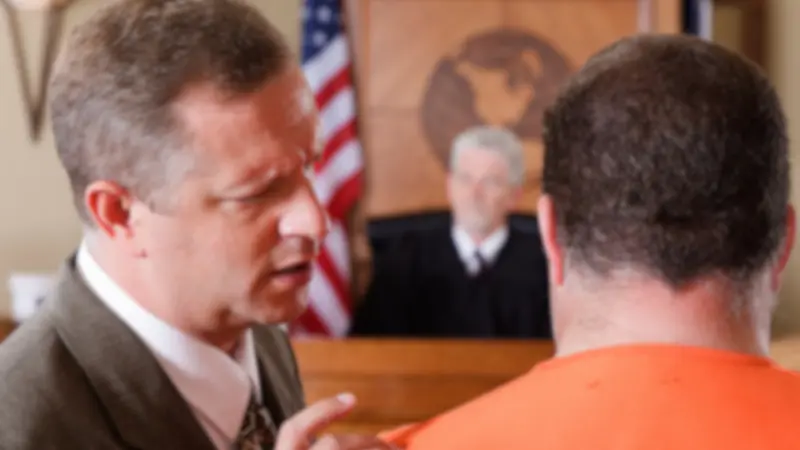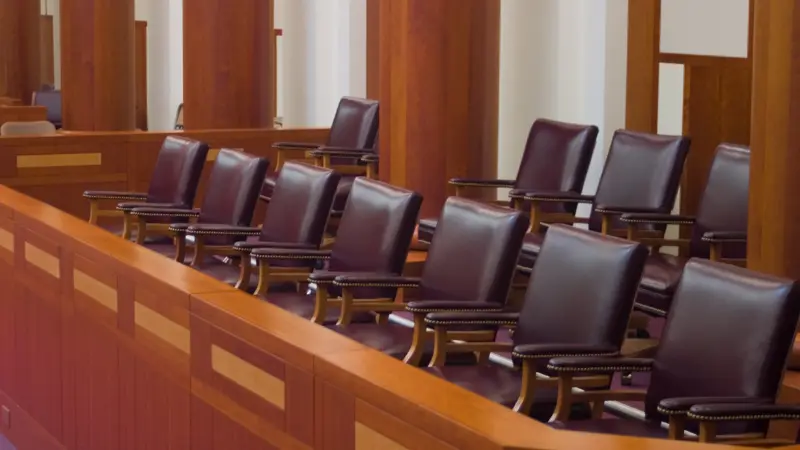TFelony trials hold immense importance within the criminal justice system, serving as the formal procedure for evaluating serious crime accusations and potential convictions. These trials encompass intricate legal processes, intense courtroom theatrics, and significant implications for both the accused and society. Familiarizing oneself with the anatomy of a felony trial is crucial for comprehending legal intricacies, participant roles, and outcome determinants. Felony trials and what goes on in court spread into different stages of such trials, unveil strategies of prosecution and defense, and illuminate courtroom dynamics, offering a detailed view of these high-stakes proceedings. As we talk about felony trial dynamics, we aim to demystify this intricate legal journey and enhance comprehension of justice pursuit within our legal framework.
The Anatomy Of A Felony Trial: What Really Goes On In Court

A Comprehensive Overview Of The Legal Proceedings
Let’s begin with the fundamentals, a felony constitutes a grave offense usually carrying a punishment of over a year’s imprisonment. We’re delving into major crimes – think murder, robbery, and drug trafficking. Felony trials are the genuine article, involving high stakes and significant repercussions.
The Importance Of A Fair Trial
A fair trial is a cornerstone of the justice system. It ensures that individuals accused of felonies are treated justly, with their rights upheld and protected throughout the legal process. This principle helps maintain a balance between punishing those who are guilty and safeguarding the rights of those who may be innocent until proven otherwise.
Pre-Trial Proceedings: Building The Case
Arrest And Initial Charges
When a felony is suspected, the police arrest the individual, and then the legal process begins. The prosecutor reviews the evidence to determine the charges to file, and the accused person’s journey through the legal system unfolds from there. The goal is to ensure that the process is fair, and transparent, and respects the rights of the accused while seeking justice for any potential victims.
Bail And Pretrial Detention
Following the arrest, the accused might have the chance to post bail, a sum of money that acts as a commitment to attend court proceedings. If bail isn’t feasible, they could be kept in pretrial detention until the trial. This period can feel like a state of uncertainty, involving orange jumpsuits, restricted phone use, and less-than-ideal cafeteria meals, certainly not a situation one would consider glamorous.
Investigation And Gathering Evidence
Once the charges are officially lodged, the prosecution and defense groups get to work delving deep into the details of constructing their arguments. This process entails collecting evidence, questioning witnesses, and striving to reveal the facts. It resembles a live detective series, though with more at stake, and the courtroom becomes the arena for the unfolding drama. Here’s to a trial without any unexpected twists in the plot.
Jury Selection
The Role Of The Jury In The Criminal Justice System
As the trial commences, the spotlight turns to the jury. These individuals hold the responsibility of determining the defendant’s destiny, making their role pivotal. They must attentively consider the evidence, assess the arguments, and ultimately render a verdict of guilt or innocence. It’s quite a weighty task, isn’t it?
Voir Dire
Is a legal term that refers to the process of questioning potential jurors to determine their qualifications and suitability to serve on a jury for a specific trial. This process helps both the prosecution and the defense to select a fair and impartial jury.
Challenges For Cause And Peremptory Challenges
After the questioning concludes, lawyers have the opportunity to object to potential jurors based on legitimate reasons, a process known as challenging for cause. Additionally, they can exercise peremptory challenges, which let them dismiss potential jurors without stating a specific reason (similar to a gut feeling). The aim is to ultimately assemble a jury that’s inclined toward your side.
Opening Statements
The Purpose Behind Opening Statements
With the jury assembled, the trial’s next phase involves preparing the groundwork. Think of opening statements as previews for a major film – they offer the jury a glimpse of what’s to come. The prosecution begins, succeeded by the defense, as both sides endeavor to captivate the jury with their persuasive accounts. It resembles a narrative showdown, where attorneys vie to establish that their rendition of events holds the most credibility.
Crafting A Compelling Opening Statement
Creating a captivating opening statement involves weaving a persuasive narrative that captures the jury’s attention from the start. This introduction should succinctly outline the case’s central themes, preview key evidence, and establish a relatable connection with the jurors. By presenting a clear and compelling overview, attorneys set the stage for the trial and lay the foundation for their arguments.
Presentation Of Evidence: Examining Witnesses And Exhibits
Direct Examination: Presenting The Prosecution’s Case
During the direct examination phase, the prosecution lays out its case by questioning witnesses. This methodical process allows them to elicit testimony and evidence that supports their narrative. By presenting a coherent and organized sequence of questions, the prosecution aims to build a compelling story that reinforces their position and convinces the jury of the defendant’s guilt.
Cross-Examination: Challenging Witness Testimony
Cross-examination is a critical phase where the opposing side questions witnesses presented by the prosecution. This process involves challenging the credibility, consistency, and accuracy of the witness’s testimony. By probing potential inconsistencies and introducing doubts, the cross-examination aims to weaken the prosecution’s case and create reasonable doubt in the minds of the jurors. It’s a strategic effort to uncover weaknesses in the witness’s account and sway the jury’s perception of the evidence presented.
Expert Witnesses And Forensic Evidence
Expert witnesses are individuals with specialized knowledge in a particular field relevant to the case. They provide opinions and insights that aid the jury in understanding complex subjects. Forensic evidence, such as DNA analysis or ballistics, is scientific information used to establish facts in the case. Both expert witnesses and forensic evidence contribute to the presentation of a credible and well-supported argument, helping to sway the jury’s perspective on the matter at hand.
Cross-Examination: Challenging The Prosecution’s Case
The Art Of Effective Cross-Examination
Mastering the art of effective cross-examination requires skillful questioning and strategy. The goal is to undermine the opposing side’s case by exposing weaknesses in witness testimony. By using leading questions, pointing out inconsistencies, and challenging the witness’s credibility, attorneys aim to create doubt in the jury’s mind. Effective cross-examination involves staying focused, listening carefully, and adapting to unexpected responses. It’s a delicate balance of assertiveness and respect, designed to unveil the truth and strengthen the cross-examiner’s argument.
Weaknesses In Witness Testimony
Uncovering inconsistencies and weaknesses in witness testimony often involves careful cross-examination, reviewing statements for contradictions, and seeking corroborating evidence. Experienced legal professionals may use various questioning techniques to highlight discrepancies and help reveal the truth during a trial or investigation.
Handling Hostile Witnesses
Handling hostile witnesses requires a strategic approach. Maintain a composed demeanor, ask clear and direct questions, and avoid escalating conflicts. Calmly address any hostile behavior and focus on obtaining relevant information. Use leading questions to guide their responses and counter any false statements with evidence or prior statements. It’s essential to stay respectful while asserting control over the situation.
Closing Arguments
Summarizing Evidence In Court
In a court setting, summarizing the evidence and reinforcing key points involves condensing the most critical pieces of evidence and arguments presented during the trial. This helps the judge and jury grasp the main aspects of the case. Effective summarizing involves focusing on key witnesses, relevant documents, and important testimony to emphasize the central themes of the case. Clear and concise language is essential to ensure that the main points are understood and retained by those involved in the proceedings.
Closing Arguments Assistance
Remember, the effectiveness of your closing argument also depends on your understanding of the case, the evidence you have, and the dynamics of the courtroom. Tailor the above structure to fit your specific situation and make sure your argument is well-organized and easy to follow.
Counterarguments And Anticipating Prosecution
To address counterarguments and anticipate the prosecution’s closing, it’s crucial to thoroughly understand their potential points and evidence. Prepare strong rebuttals based on facts, logic, and legal principles. Consider how your arguments hold up against their potential claims. This proactive approach can strengthen your case and help you prepare a comprehensive and persuasive response.
Verdict And Sentencing
Long-Awaited Verdict
After days or even weeks of deliberation, the jury reveals their decision. The courtroom holds its breath as the verdict is announced. Guilty or not guilty? It’s a moment that can change lives forever.
The Sentencing
If the defendant is found guilty, it’s time for the judge to step in and determine their fate. Should they get a slap on the wrist or face the full wrath of the law? The judge weighs the evidence, considers any aggravating or mitigating factors, and tries to find a sentence that fits the crime.
Appeals And Post-Trial Proceedings
Appeals and post-trial proceedings refer to legal processes that occur after a trial has concluded. This involves asking a higher court to review and potentially overturn a lower court’s decision. Post-trial proceedings encompass various actions that can take place after a trial, such as motions for a new trial, sentencing hearings, and other legal actions to address issues that may have arisen during or after the trial. These processes are essential parts of the legal system to ensure fairness and the correct application of the law.
Read:
- What Happens To Your Property If You Go To Jail For Over A Year?
- Can Felons Live Together?
- Can A Felon Own A Sword?
- Can Felons Change Their Names?
- Highest Felony One Can Commit In The US?
- Expungement Of A Criminal Record
Summary

To sum up, dissecting a felony trial exposes the complexities and difficulties of the legal procedure. Starting with pre-trial steps and extending to evidence presentation, cross-examination, and concluding arguments, every phase plays a pivotal role in shaping the trial’s result. Through delving into these components, we develop a more profound comprehension of the endeavors undertaken by both the prosecution and defense in the pursuit of justice. A felony trial stands as evidence of the core tenets of our legal framework, striving to uphold equity, safeguard the accused’s rights, and ultimately achieve a fair judgment.

Human right activist, writer, married and passionate about felons. Pearl loves to travel, cook and hates injustice of any kind. She gives and writes helpful info people can read for enlightenment.
